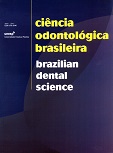Strain Gauge: study of strain distributions around three Morse taper prosthetic connections with offset positioning in machined and plastic copings under vertical load
DOI:
https://doi.org/10.14295/bds.2012.v15i3.823Abstract
The aim of this study was to evaluate through strain gauge the strain distribution occurred around 3 Morse taper implants with positioning offset, by varying the types of copings: plastic and machined. Microunit prosthetic abutments were connected onto the implant platforms. Ten frameworks composed of 3 copings were casted in cobalt-chromium alloy as single block (Co-Cr). Half of the copings were machined (n=5) and half were made of plastics (n=5). Four strain gauges were placed into the polyurethane block tangential to the 3 implants. The frameworks were fixed at their respective sites with the aid of a retaining screw with torque of 20 N.cm, achieve with a mechanical torquemeter. The vertical load of 30 Kg was applied through a spherical point of 2 mm diameter for 10 s, onto each one of the 3 screws of the framework through a device for load application The records of the strain reading were submitted to ANOVA and Tukey tests (5%). There were statistically significant differences (p=0.0174) between the coping type used (machined and plastic). The micro strain mean values were: point C at the machined coping 282.5 ?m (±120.8), point B at the machined coping 229.5 ?m (±76.1), point A at the machined coping 209.8 ?m (±55.0), point C at the plastic coping 155.0 ?m (±30.5), point B at the plastic coping 146.2 ?m (±25.8) and point A at the plastic coping 130.36 ?m (±21.83). It was concluded that there was a significant difference between the coping types, once the plastic coping exerted smaller micro strain on Morse taper implants than the machined copings.
Downloads
Downloads
Additional Files
Published
How to Cite
Issue
Section
License
Brazilian Dental Science uses the Creative Commons (CC-BY 4.0) license, thus preserving the integrity of articles in an open access environment. The journal allows the author to retain publishing rights without restrictions.
=================




























